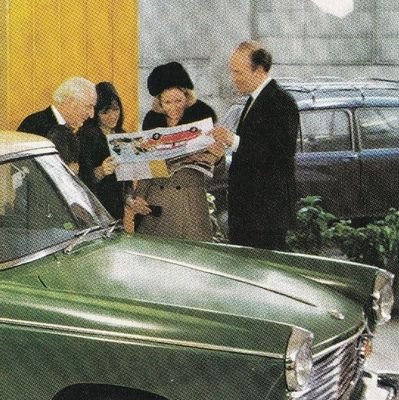A Pontiac that never was, the G8 6.0-litre pick-up was supposed to join the range for the 2010 model year. It was based on the Ute version of the Australian Holden Commodore. Unfortunately events overtook the plans, as Pontiac itself was terminated in 2009. #carbrochure #Pontiac
The 'new' Talbot marque's supermini, the Samba, was all-too-obviously a warmed-over Peugeot 104, so to add interest to the range a cabriolet version built by Pininfarina was fast-tracked to launch. It was then said to be the world's smallest convertible. #carbrochure #Talbot
The K8's exterior design was supposed to evoke the styling themes of Hispano Suiza cars of the 1920s, combined with a rather minimalist-looking interior. It was shown at the Geneva Show as a non-running prototype, with a V8 engine and all-wheel-drive proposed.
Hyundai's new FWD mid-size car, the Lantra (also known as Elantra in some markets) was an important addition to the company's range, taking over from the outdated Stellar. Only sold as a saloon, it came in 1.6GLSi and Cdi versions in this 1991 UK brochure. #carbrochure #Hyundai
The place of the GL and GLs in the 1980 Saab 900 range is shown in this graphic, which also notes the essential differences. At this stage only hatchbacks were available in the 900 line-up - later on, 4-door, 2-door and finally convertible styles would join the range.
Ahead of today's historic state funeral for Queen Elizabeth, here's a reminder that in the 1950s the traditional Daimler marque was very much the choice of the British Royal family. This brochure features a typical model of the era, the 1954 Regency mkII. #carbrochure #Daimler
The centre-spread contained an essential part of any self-respecting 1970s luxury car brochure, a cut-out drawing of the new model, which would sadly be Opel's last coupé in this class.
Effectively a Fiat 500 in a posher frock, the Autobianchi Bianchina was first launched in 1957. Its Panoramica estate version - capable of carrying four adults plus luggage - is shown in this 1960s brochure for France. #carbrochure #Autobianchi
@alhodg No, they were British, built at Dagenham. Fordson was used on tractors as well as commercials at the time. Ford of Britain later moved to using Thames as a sub-marque for commercial vehicles.
Also offered at the time was the extravagant new Le-Seyde, based on a Nissan Silvia S15, and the Nissan Cube-based Yuga, inspired by the TX1 taxi which Mitsuoka also imported and sold. The Zero-1 Classic is shown on a separate page, picturing the company founder, Susumu Mitsuoka.






















